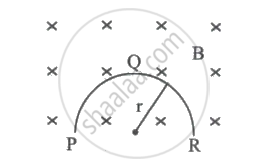Advertisements
Advertisements
प्रश्न
State and explain Lenz’s law in light of the principle of conservation of energy.
उत्तर
Lenz's law: The direction of the induced current is such as to oppose the change that produces it.
The change that induces a current may be
- the motion of a conductor in a magnetic field or
- the change of the magnetic flux through a stationary circuit.
Explanation: Consider Faraday's magnet-and coil experiment. The number of magnetic lines of induction (pointing to the left) through the coil increases as the bar magnet is moved towards the coil with its N-pole facing the coil, as shown in the first figure. The induced current in the coil creates its own magnetic field pointing to the right (as determined by Ampere's right-hand rule) to oppose the magnet's growing flux. As a result, we must do work to move the magnet towards the coil against the repulsive flux of the induced current. The work done manifests itself as electric energy in the coil.

The number of magnetic lines of induction (pointing left) through the coil decreases as the magnet is withdrawn with its N-pole still facing the coil. As illustrated in the second figure, the induced current switches direction to augment the decreased flux with its own. The induced current is in the clockwise direction while facing the coil and the magnet. The coil's electric energy originates from the work done to pull the magnet away from an attractive force. Thus, we see that Lenz's law is a consequence of the law of conservation of energy.
APPEARS IN
संबंधित प्रश्न
State Lenz's Law.
Lenz's law obeys the principle of ______ conservation.
A thin semicircular conducting ring (PQR) of radius r is falling with its plane vertical in a horizontal magnetic field B, as shown in figure. The potential difference developed across the ring when its speed is v, is ____________.

Eddy currents are produced in a material when it is ____________.
A coil having effective area A, is held with its plane normal to a magnetic field of induction B. The magnetic induction is quickly reduced to 25% of its initial value in 4 s. Then e.m.f. induced across the coil will be ____________.
A conducting circular loop is placed in a uniform magnetic field 0.02 T with its plane perpendicular to the magnetic field. The radius of the loop starts shrinking at 2 mm/s. The induced e.m.f. in the loop when the radius is 2 cm will be ____________.
The rate of change of magnetic flux density through a circular coil of area 10-2 m2 and number of turns 200 is 103 Wb/m2 s. The value of induced e.m.f. will be ____________.
Metal rings 'P' and 'Q' are lying in the same plane where current 'I' is increasing steadily. The induced current in metal rings is shown correctly in figure.

A magnetic field of 2 x 10-2 T acts at right angles to a coil of area 50 cm2 with 100 turns. The average e.m.f. induced in the coil is 0.2 V, when it is removed from the field in time t. The value of t is ____________.
Two identical circular loops of metal wire are lying on a table without touching each other. Loop-A carries a current which increases with time. ln response, the loop-B ____________.
Why the ring jumps several metres in air in jumping ring experiment?
